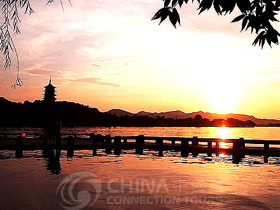Zhejiang Province is situated on China's southeastern coast in the southern part of the Yangtze River Delta, northeast of Shanghai. It covers a total land area of 101,800 square kilometers, most of which are hills and mountains. The province's coastline stretches 6,486 km. Zhejiang also has the largest number of islands in China, with 3,061 islands having a land area of 500 square meters or larger.
Zhejiang has a sub-tropical monsoon climate, with four distinct seasons and abundant sunshine. The average annual temperature is 15°C - 18°C and the average annual precipitation is 1,200-1,800 mm. Its rainy season is from May to June; its coldest and hottest days are seen in January and July respectively.
Zhejiang is one of the birthplaces of Chinese civilization. As early as the Old Stone Age 50,000 years ago, the primitive Jiande Man lived in the mountainous western region of the province. During the New Stone Age of 7,000 to 4,000 years ago, human activities extended to a wider area, leaving more than 100 cultural sites in the area, including those from the Hemudu Culture (6,000 to 7,000 years ago), the Majiabang Culture (about 6,000 years ago) and the Liangzhu Culture (about 4,000 to 5,000 years ago). Among the cultural relics found in the Yuyao Hemudu Cultural Site are all types of farming and daily life utensils made of bone, stone, pottery and wood; grains; wooden parts of house-structures; colorful lacquer bowls and bone whistles that can still produce beautiful music. During the 12th and 13th century AD, Hangzhou served as the Southern Song dynasty's capital for 150 years. In the 14th century, "Zhejiang" became the formal name of the province. In China's history, Zhejiang was famous for its developed farming skills and handicrafts. It led the country in industries such as silk, porcelain, papermaking, printing and shipbuilding.
 As Zhejiang is blessed with rich natural and cultural tourism resources, it attracts numerous visitors from abroad every year. The province has a long history and brilliant culture, with charming natural, historical and cultural heritage spots. It has enjoyed the name, "the land of fish and rice, place of silk and tea, town of cultural and historical relics, and destination of tourist attraction." The whole province has 16 state-level scenic areas, including the West Lake, Fuchun River, Xin'an River, Thousand-islet Lake, Mount Yantang, Nanxi River, Mount Putuo, the Shengsi Islands, Mount Tiantai, Mount Mogan, Mount Xuedou, Twin Dragon Cave and Mount Xiandu, in addition to its 35 province-level scenic spots. The Hangzhou River is a national holiday resort, with 10 provincial resorts, including Xianghu Lake in Xiaoshan, Oujiang River in Wenzhou and Mount Huiji in Shaoxing. West Lake, located in the heart of the provincial capital Hangzhou, is one of the most beautiful sights in the province.
As Zhejiang is blessed with rich natural and cultural tourism resources, it attracts numerous visitors from abroad every year. The province has a long history and brilliant culture, with charming natural, historical and cultural heritage spots. It has enjoyed the name, "the land of fish and rice, place of silk and tea, town of cultural and historical relics, and destination of tourist attraction." The whole province has 16 state-level scenic areas, including the West Lake, Fuchun River, Xin'an River, Thousand-islet Lake, Mount Yantang, Nanxi River, Mount Putuo, the Shengsi Islands, Mount Tiantai, Mount Mogan, Mount Xuedou, Twin Dragon Cave and Mount Xiandu, in addition to its 35 province-level scenic spots. The Hangzhou River is a national holiday resort, with 10 provincial resorts, including Xianghu Lake in Xiaoshan, Oujiang River in Wenzhou and Mount Huiji in Shaoxing. West Lake, located in the heart of the provincial capital Hangzhou, is one of the most beautiful sights in the province.

